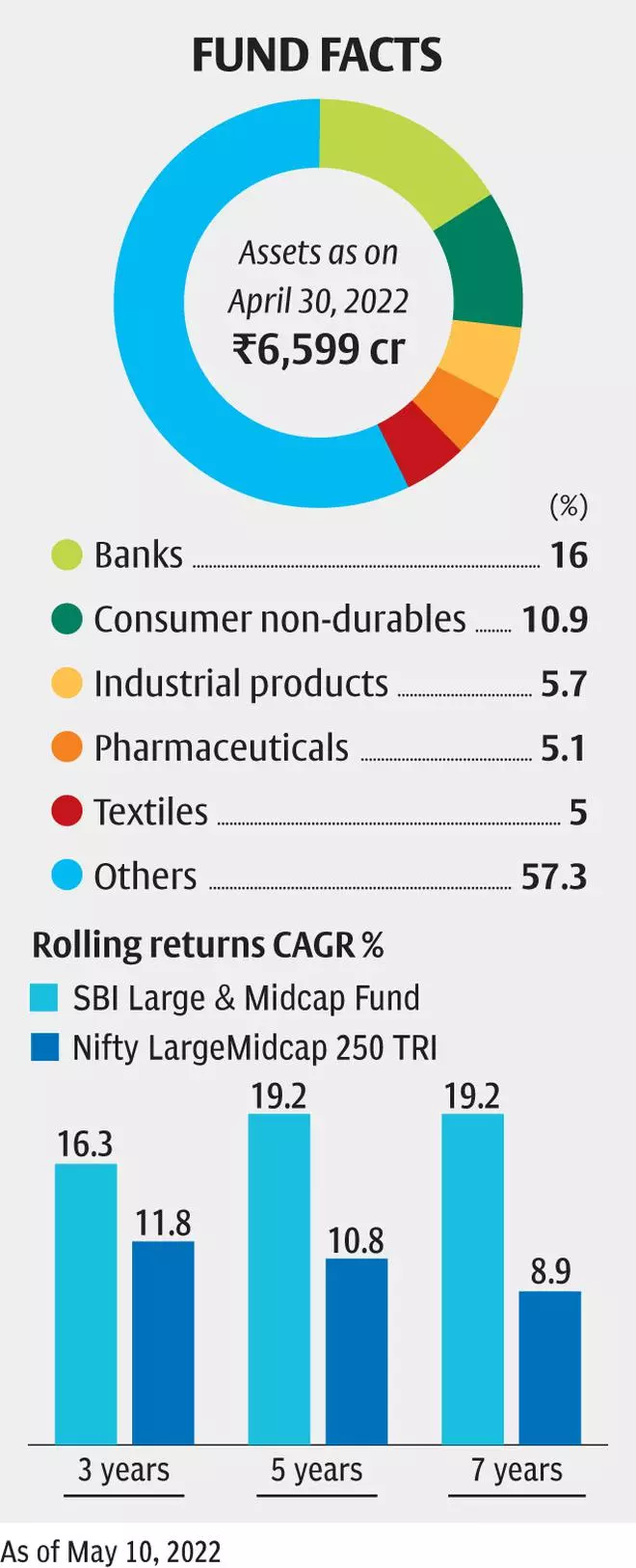The Indian stock market has slid by 10 per cent in the last one month. This correction provides an opportunity for long-term investors to add positions in equity asset class. Those looking for options could consider a right mix of steady large-caps and growth-oriented mid-caps. In this context, SBI Large & Midcap Fund could provide the ideal recipe for returns if your holding period is five years or more. A good performer with above-average returns, the fund is a low-risk option in volatile markets. To efficiently manage volatility, investors should consider investing in a staggered manner by way of SIPs and spread their investments over a longer period of time.
Competitive performance
Before SEBI came up with regulations on categorisation and rationalisation of mutual fund schemes, SBI Large & Midcap Fund was known as SBI Magnum Multiplier Fund (launched in 1993), which used to be predominantly large-cap oriented. with over 50 per cent allocation in 2017. It currently holds 37 per cent in large-caps, 39 per cent in mid-caps, 19 per cent in small-caps and 5 per cent in cash-equivalents.
The fund (direct plan) has comprehensively beaten its category average returns across one-, three- and five-year periods and has also outperformed benchmark Nifty Large Midcap 250 Total Return Index (TRI) by 40-425 basis points in these periods.
In the last one, three and five years, the fund has, to its credit, secured near top quartile position among category peers as well. This is a reflection of the stability and competitive performance brought on by fund manager Saurabh Pant who took over this fund in the second half of 2016.
Over the long-term such as 10- and 15-year periods, the fund features in the top-five club, but do note these returns are of an era when the fund wasn’t entirely a large and midcap one.
In terms of rolling returns, the fund has outshone Nifty Large Midcap 250 TRI over 3, 5, 7 and 10-year periods on a daily rolling return basis over the last 15 years (see table). Also, the fund has rarely delivered negative returns, once the holding period is five years.
In the last three years, which falls under the fund’s newest avatar, the scheme has managed downsides well, evident from downside capture ratio (DCR). With a DCR of 93 per cent, the fund has fallen less than the overall category (96 per cent). Not just that, the scheme has also captured more of the upside (3-year upside capture ratio of 96 per cent) during good times compared to category average (94 per cent).
Portfolio and strategy
SBI Large & Mid Cap Fund invests across sectors following a blend of growth and value style of investing and a combination of top-down and bottom-up approach to stock-picking. The portfolio valuation in terms of PE at 44 times is tilted towards growth, compared to category range of 28 to 55 times.
The fund aims to benefit from the scale of large-caps and growth potential of mid-cap companies. The fund usually maintains a portfolio of 55-60 stocks and has adequate diversification.

As a large and mid-cap fund, the fund is mandated to invest 35 per cent each in large-caps and mid-caps (total 70 per cent). But in contrast to most peers, the fund has shown a tendency to use the balance 30 per cent more in mid and small-caps, than seek refuge in large-caps as competitors do. Sticking to quality names can help it limit downside risks, while participating in upside opportunities.
While the fund’s investment style is slightly on the aggressive side as evident from the higher mid and small-cap stocks exposure, execution has so far been good. Some risk management is evident, for instance, the fund has kept its top 5, 10 and 20 stocks concentration lower than category average.
With inflation emerging as near-term challenge, value stocks tend to do well. Also, the market’s earning expectations remains intact, even though it has witnessed a notable correction in several stocks from peaks. In this backdrop, the fund’s portfolio of blend of growth and value may deliver. The fund has a good mix of defensives and cyclicals. Banks have generally been the most-favoured segment. It is followed by auto and ancillaries, FMCG, healthcare, capital goods, textiles and oil. Over the last one year, the fund has cut down exposure to industrial products, pharma, finance, software, cement and gas. Allocations have increased a bit in petroleum products, hotels, telecom, ferrous metals etc. Do note the fund’s expense ratio is a tad higher relative to category.








Comments
Comments have to be in English, and in full sentences. They cannot be abusive or personal. Please abide by our community guidelines for posting your comments.
We have migrated to a new commenting platform. If you are already a registered user of TheHindu Businessline and logged in, you may continue to engage with our articles. If you do not have an account please register and login to post comments. Users can access their older comments by logging into their accounts on Vuukle.